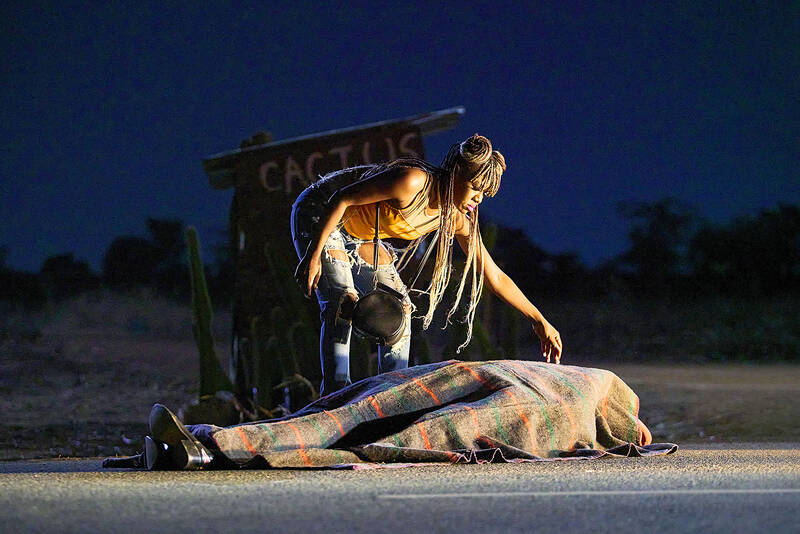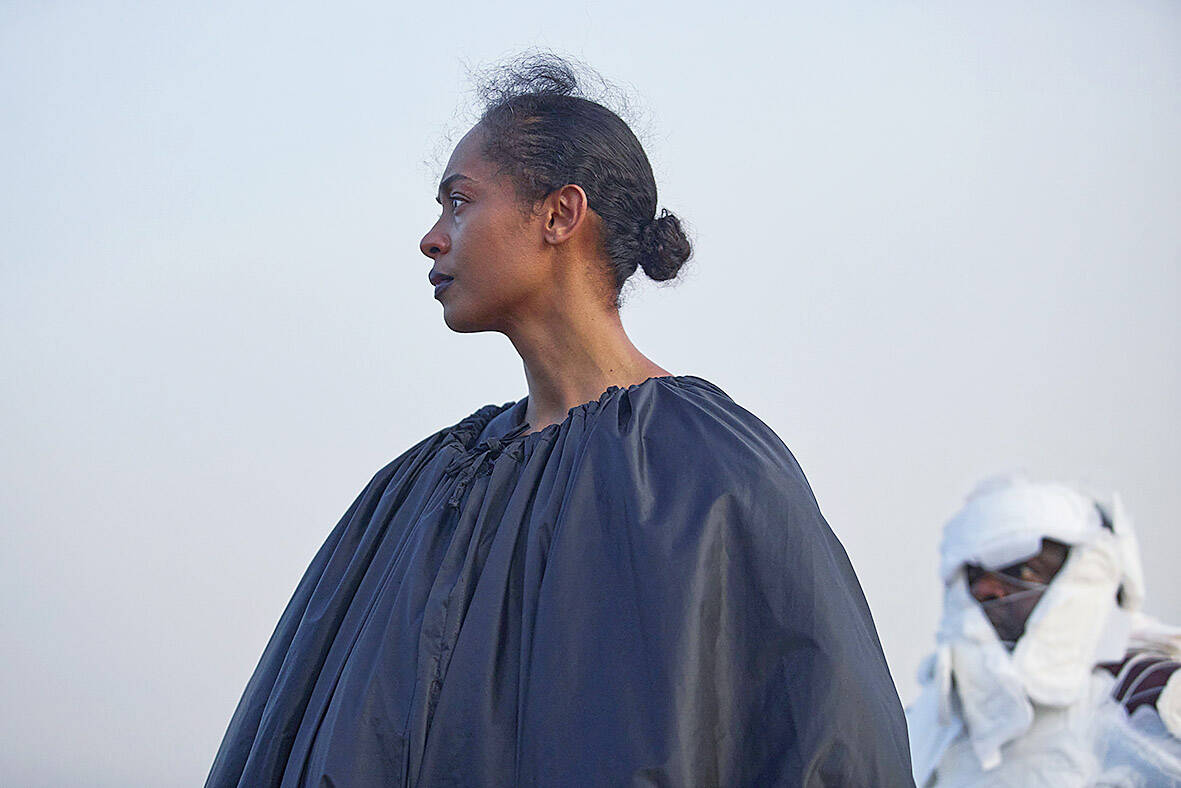Shula is driving home from a fancy dress party one night when she encounters an unusual sight in the middle of a country road: her Uncle Fred’s dead body.
But Shula, portrayed by Susan Chardy, does not behave in a way that we would expect. She doesn’t cry out in horror or appear the least bit upset or shocked by the sight. Instead, we sit there with her in silence, her in sunglasses and a silver helmeted mask adorned with sparkling rhinestones. Shula looks straight out of a music video as she stares off into the distance. This, we realize quickly, is going to be a thing. At the very least, it’s an inconvenience, ripping her out of her independent life and back into the throes of her traditional family, their patriarchal ways and all their crippling secrets.
This is the opening scene of On Becoming a Guinea Fowl, Rungano Nyoni’s darkly comedic, stylish and hauntingly bizarre portrait of a Zambian family funeral. It is perhaps the first great film of this year. It premiered last year at the Cannes Film Festival and has already had a run in the UK.

Photo: AP
And it’s a post-Oscars treat to have something this great in the cinemas to shake audiences out of their end-of-the-road awards contender boredom. What better way to do it than with something so different, so vibrant and so unforgettable as On Becoming a Guinea Fowl, only the second feature from the self-taught filmmaker.
Nyoni centers this story around a dayslong funeral for this predominately Bemba family. Shula is in the middle of the generations involved, a reluctant but obedient participant in the rituals of the elders. The women organize all the things, make all the food, and then serve all the men who are sitting around doing nothing. Eventually, they’ll all gather for a climactic, distressing scene in which they divide up Fred’s assets and place blame for his death. It is, like everything else, deeply unfair and misogynistic, coming down to whomever shouts loudest.
The elder women cry and wail and are cruel to Uncle Fred’s widow for not taking care of him. But there is an open secret that’s bubbling up to the surface now that Fred is dead: He was a predator and a pedophile whose abuse of the young women in his family stretches back decades. This is, most of the elders agree, something that should just be forgotten and buried along with Fred.

Photo: AP
“Do you want me to dig up the corpse and ask it what happened?” Shula’s dad asks when she confronts him with the truth.
This is a society that remains bound to protecting the reputation and memory of a man whose actions continue to affect the women he violated: His wife; his young niece; Shula’s grown, often drunk cousin (Elizabeth Chisela). The women are just supposed to compartmentalize and move on — something the matriarchs seem largely on board with.
Shula reads one of her auntie’s words, presumably for an obituary: “You were not just a brother, but also a father figure. … Ever jovial and joyous. A person who was fair.”

Photo: AP
Done in quick succession with her young cousin Bupe’s confession that she too was a victim of the deceased, words like “father figure” and “jovial” echo with malice.
On Becoming a Guinea Fowl shares some spiritual DNA with Women Talking, in which mothers pass on traumas and secrets and the cycle goes on, despite even the best of intentions. Nyoni and her cinematographer David Gallego make this a transportive, stylish and unforgettable experience that powerfully transcends the specifics of its setting, while also taking audiences into an culture that’s likely unfamiliar.
The ending is not what one might call conclusive, but perhaps a litmus test for the individual viewer as to whether or not they’ll exit with hope or dread for what’s to come. And regardless, when you take a step back, Guinea Fowl cements the exciting arrival of a true filmmaker.

Photo: AP

The People’s Republic of China (PRC) last week offered us a glimpse of the violence it plans against Taiwan, with two days of blockade drills conducted around the nation and live-fire exercises not far away in the East China Sea. The PRC said it had practiced hitting “simulated targets of key ports and energy facilities.” Taiwan confirmed on Thursday that PRC Coast Guard ships were directed by the its Eastern Theater Command, meaning that they are assumed to be military assets in a confrontation. Because of this, the number of assets available to the PRC navy is far, far bigger

The 1990s were a turbulent time for the Chinese Nationalist Party’s (KMT) patronage factions. For a look at how they formed, check out the March 2 “Deep Dives.” In the boom years of the 1980s and 1990s the factions amassed fortunes from corruption, access to the levers of local government and prime access to property. They also moved into industries like construction and the gravel business, devastating river ecosystems while the governments they controlled looked the other way. By this period, the factions had largely carved out geographical feifdoms in the local jurisdictions the national KMT restrained them to. For example,

The remains of this Japanese-era trail designed to protect the camphor industry make for a scenic day-hike, a fascinating overnight hike or a challenging multi-day adventure Maolin District (茂林) in Kaohsiung is well known for beautiful roadside scenery, waterfalls, the annual butterfly migration and indigenous culture. A lesser known but worthwhile destination here lies along the very top of the valley: the Liugui Security Path (六龜警備道). This relic of the Japanese era once isolated the Maolin valley from the outside world but now serves to draw tourists in. The path originally ran for about 50km, but not all of this trail is still easily walkable. The nicest section for a simple day hike is the heavily trafficked southern section above Maolin and Wanshan (萬山) villages. Remains of

Shunxian Temple (順賢宮) is luxurious. Massive, exquisitely ornamented, in pristine condition and yet varnished by the passing of time. General manager Huang Wen-jeng (黃文正) points to a ceiling in a little anteroom: a splendid painting of a tiger stares at us from above. Wherever you walk, his eyes seem riveted on you. “When you pray or when you tribute money, he is still there, looking at you,” he says. But the tiger isn’t threatening — indeed, it’s there to protect locals. Not that they may need it because Neimen District (內門) in Kaohsiung has a martial tradition dating back centuries. On